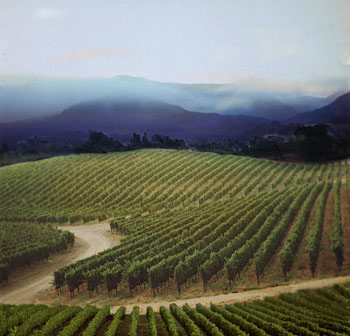

Faust Wine's vineyard in east Napa exhibits the cool, foggy influences typical of the area.
Why Cool Coombsville is HOT
Just as the pending Calistoga AVA remains in controversial limbo, at the other end of Napa Valley, a bitter brawl is underway about not only the naming of an AVA but its boundaries.
by
Alan Goldfarb
October 8, 2008
 n case you haven’t noticed - and chances are you haven’t – save for a little dust-up over a name, the so-called Coombsville area east of the city of Napa is the hottest spot for grapes these days in the Napa Valley. Sitting on a plateau under the imposing Mt. George, the growers in the region are experiencing a come-to-the-mountaintop moment, while at the same time they’re trying to figure out what the heck to call their little corner of America’s most important wine region.
n case you haven’t noticed - and chances are you haven’t – save for a little dust-up over a name, the so-called Coombsville area east of the city of Napa is the hottest spot for grapes these days in the Napa Valley. Sitting on a plateau under the imposing Mt. George, the growers in the region are experiencing a come-to-the-mountaintop moment, while at the same time they’re trying to figure out what the heck to call their little corner of America’s most important wine region.
The farmers, the few brick and mortar wineries in the neighborhood, and those that source their grapes from the region are bogged down in a to-do over an attempt to get AVA (American Viticultural Area) status. But a proposal to name the area “Tulocay” - by what some in the area say was a minority of interlopers - was sent back by the feds, who rejected it. (See sidebar-How to Name This AVA-below.)
In the interim, those that live in the area and farm the grapes are producing some of the more intriguing red Bordeaux and Chardonnay to come out of the Napa

Here is the general area of contention of the Coombsville region of Napa Valley.
It is fruit that is turning out red wines that are very dark in color – mostly blue-black (and not unlike Superman’s hair) – with flavors of blackberries, black plums, mulberries, and dried herbs and black olives. Their textures are silky with very soft and fine tannins, the body is smooth and elegant with subtle power; and they seem to be in sync with reasonable alcohol levels, definitive acidity, and length.
Coombsville, because of its proximity to San Pablo Bay, is cooler than up-valley vineyards. Thanks to that temperate climate, the

Dawnine Dyer
In addition to Meteor, there are a few actual wineries here such as Palmaz, Caldwell, Tulocay, Ancien, Frazier, Sodero, and Farella Park. There are about a dozen-and-a-half grower/brands such Tournesol, Haynes, Faust (Quintessa), Michael Black, Robert Craig, Far Niente/Dolce, Arcadia (owned by Warren Winiarski), Black Oak, Miller, Rocca, Richard Perry, Elke, Black Cat, Hagen Heights, and Bighorn.
In recent years, some other high-profile producers and winemakers have been using Coombsville’s fruit, including Merus, Lail, Star Hill, Havens, Etude, Vineyard 29, Arietta, and Favia; and Philippe Melka, Mia Klein, Aaron Pott, and Andy Erickson.
In the 1980s and ‘90s, before almost anyone outside of the Napa Valley had heard the word Coombsville, Randy Dunn was sourcing grapes from there, as was Joseph Phelps for its signature Insignia wine. That’s quite a litany and a testament to the efficacy of Coombsville and the quality of its grapes.

Perhaps the single most important factor seems to be Coombsville’s climatic conditions, in deference to its soil properties.
Michael Wolf, a vineyard management consultant, who farms more than 100 acres in Coombsville, concurs about trying to pin it down. “It’s a hard region to generalize about, which is one of the things that’s interesting about it,” he says. “(But) it’s a region that lends itself nicely to making single-vineyard wines.”
Perhaps the single most important factor seems to be Coombsville’s climatic conditions, in deference to its soil properties. Grapes ripen there over a long period of time – perhaps longer than most places in the valley – without pushing the sugars that lead to reasonable alcohol percentages. It’s likely a key component at the moment, when there’s a trend seemingly toward ratcheting down the wines.
Taking time from the difficult 2008 harvest, Wolf explains to APPELLATION AMERICA the even maturation process that Coombsville affords: “It seems to be (a factor),” he says. “… We’re looking at maturity levels now in the mid-24s here, when up-valley it’s 27.5° (Brix). This is

Tom Farella
Further commenting on the intermediary qualities that seem to inhabit and inform Coombsville, Tom Farella of Farella Park Vineyard says: “It’s not a mountain area. It’s not a valley floor area. But it’s a plateau.”
With elevations of about 300 to 500 feet, Coombsville’s 900 planted acres are under a horseshoe-shaped ridge - what Jonathan Swinchatt and David Howell in their book “The Winemaker’s Dance” (University of California Press) called the “cup and saucer” of Coombsville.
Farella describes the soil here as not comprised of “a grain of clay loam or river bottom. It’s mostly fine, volcanic ash from volcanoes elsewhere; and an overlay of riolitic tuft (gravelly and red) that has been crumbling over millennia.”
Aaron Pott was at the center of the controversy surrounding the AVA petition, when he was quoted

This photo and below: Views of the Coombsville area vineyards seen from Coombsville Road in Napa.
Mike Wolf goes a bit further in his effusiveness. “I’m crazed over wines expressing the vineyard and down there (in Coombsville) it really lends itself to that. It’s an interesting and developing area.”
No matter what you call it. <










 READER FEEDBACK: To post your comments on this story,
READER FEEDBACK: To post your comments on this story,





